
About UsThe Numismatic Bibliomania Society is a non-profit organization promoting numismatic literature. For more information please see our web site at coinbooks.org SubscriptionsThose wishing to become new E-Sylum subscribers (or wishing to Unsubscribe) can go to the following web page link MembershipThere is a membership application available on the web site Membership Application To join, print the application and return it with your check to the address printed on the application. Membership is only $15 to addresses in the U.S., $20 for First Class mail, and $25 elsewhere. For those without web access, write to: David M. Sundman, Treasurer AsylumFor Asylum mailing address changes and other membership questions, contact David at this email address: dsundman@LittletonCoin.com SubmissionsTo submit items for publication in The E-Sylum, just Reply to this message, or write to the Editor at this address: whomren@gmail.com
BUY THE BOOK BEFORE THE COIN |
- WAYNE'S WORDS: THE E-SYLUM SEPTEMBER 22, 2013
- NEW BOOK: AMERICAN GOLD AND PLATINUM EAGLES
- NEW BOOKS IN THE MONETA SERIES: #156-#160
- BOOK REVIEW: OPHTHALMOLOGIA OPTICA ET VISIO IN NUMMIS
- BOOK REVIEW: AMERICAN SILVER EAGLES, 2ND EDITION
- CATALOG REVIEW: SPINK'S SALEM SALE OF AFRICAN PAPER MONEY
- JAMES C. SPILMAN, 1926 - 2013
- VIRTUAL BOOK SIGNING 'ABRAHAM LINCOLN, BEYOND THE AMERICAN ICON'
- NOTES FROM E-SYLUM READERS: SEPTEMBER 22, 2013
- QUERY: NATIONAL COIN ALBUM ROMAN COIN PAGES SOUGHT
- QUERY: INPUT FOR NEW SMITHSONIAN NUMISMATIC EXHIBIT SOUGHT
- SMITHSONIAN NATIONAL POSTAL MUSEUM GROSS GALLERY OPENS
- FORT MCHENRY QUARTER LAUNCH CEREMONY REPORT
- MORE ON THE VALUE OF A MEDAL OF HONOR
- MEDAL OF HONOR SOCIETY HOLDS 2013 CONVENTION
- QUERY: WHAT IS A SPINNERET MACHINE?
- BANK OF ENGLAND STIFLES REQUEST FOR NAME OF BANKNOTE ALTERNATES
- ARTICLE DISCUSSES MARKET FOR FANCY SERIAL NUMBERS
- QUERY: WHOSE NUMISMATIC LIBRARY DID BLUESTONE SELL IN 1947?
- NATIONAL BANK OF CAMBODIA PLANS MONEY MUSEUM
- MULLIGAN MINT FILES FOR BANKRUPTCY
- RARE EDWARD VIII THREE PENCE PATTERN BEING AUCTIONED
- BALDWIN'S ARIELLE COLLECTION OF BRITISH COLONIAL COINS
- SANTA BARBARA LUCKY PENNY RESTAURANT HAS WALL OF COINS
- SILVER DOLLARS JAM COIN COUNTER, FOILING THIEVES
- FEATURED WEB PAGE: SOUTH AFRICAN RAND
Click here to access the complete archive
To comment or submit articles, reply to whomren@gmail.com
WAYNE'S WORDS: THE E-SYLUM SEPTEMBER 22, 2013

New subscribers this week include Massimo Bosi. Welcome aboard! We have 1,671 email subscribers, plus 247 followers on Facebook.
This week we open with six new numismatic books and three reviews of recent releases. Other topics include Colonial Newsletter editor Jim Spilman, fancy serial numbers, and a planned new National Numismatic Collection exhibit.
To learn more about the Mulligan Mint, Edward VIII's pattern thrupenny bit, Ophthalmologia in Nummis, the Ibrahim Salem paper money collection of Africa, the spinneret machine, and "show and tell" on steroids, read on. Have a great week, everyone!
Wayne Homren
Editor, The E-Sylum
NEW BOOK: AMERICAN GOLD AND PLATINUM EAGLES
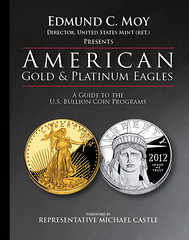 Whitman Publishing announces the release of American Gold and Platinum Eagles: A Guide to the U.S. Bullion Coin Programs, by Edmund C. Moy, retired director of the United States Mint. The 224-page hardcover book will be available November 26, 2013, online and from bookstores and hobby retailers nationwide. It can be pre-ordered at www.Whitman.com. The retail price is $29.95.
Whitman Publishing announces the release of American Gold and Platinum Eagles: A Guide to the U.S. Bullion Coin Programs, by Edmund C. Moy, retired director of the United States Mint. The 224-page hardcover book will be available November 26, 2013, online and from bookstores and hobby retailers nationwide. It can be pre-ordered at www.Whitman.com. The retail price is $29.95.
Since 1986 the hugely popular .9167 fine American Gold Eagle bullion coins have been collected by numismatists, stockpiled by investors large and small, and treasured by gold buyers throughout the United States and around the world. American Platinum Eagles were added to the Mint’s bullion offerings in 1997, and today are a best-selling way to add .9995 fine platinum to investment portfolios, in addition to being collectible themselves.
Now, no less an expert than Edmund Moy—director of the U.S. Mint from 2006 to 2011—shares his unique insight and perspective on these beautiful pieces of Americana.
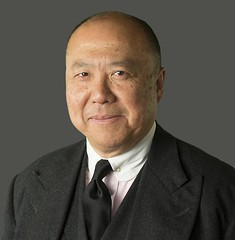 To create this book, Moy has drawn on his experience directing the Mint during a turbulent period of unprecedented growth, when silver, gold, and platinum bullion sales skyrocketed during the Crash of 2008 and the Great Recession. He takes the reader behind the scenes at the U.S. Treasury Department and into the back rooms and offices of the U.S. Mint. He lays out the history of America’s gold and platinum bullion programs; explores the foundations and nuances of investing in precious metals; and shares his insight on fascinating topics like the Langbord family’s 1933 double eagles, the recently proposed $1 trillion platinum coin, and the Mint’s 2009 Ultra High Relief gold masterpieces.
To create this book, Moy has drawn on his experience directing the Mint during a turbulent period of unprecedented growth, when silver, gold, and platinum bullion sales skyrocketed during the Crash of 2008 and the Great Recession. He takes the reader behind the scenes at the U.S. Treasury Department and into the back rooms and offices of the U.S. Mint. He lays out the history of America’s gold and platinum bullion programs; explores the foundations and nuances of investing in precious metals; and shares his insight on fascinating topics like the Langbord family’s 1933 double eagles, the recently proposed $1 trillion platinum coin, and the Mint’s 2009 Ultra High Relief gold masterpieces.
Edmund Moy brings together diverse elements—artistic as well as technical, some steeped in history and others inspired by the latest news headlines, appealing to investors as well as collectors—to make American Gold and Platinum Eagles a valuable addition to every American’s bookshelf.
“Just counting the one-ounce American Gold Eagles, collectors and investors have purchased more than 15 million coins since 1986,” said Whitman publisher Dennis Tucker. “Add to that millions of the smaller fractional-ounce gold coins, and the Mint’s Proofs and other collector formats, plus the platinum series with its historical designs. American Gold and Platinum Eagles is the world’s first book-length study of these popular coins.”
Contents include:
- A foreword by Representative Michael Castle, who coauthored the legislation that created the State quarters program, as well as the Mint’s platinum bullion coinage.
- Chapter 1: The Gold Rush of 2008. Meetings with Treasury Secretary Hank Paulson. The surge in bullion demand. Uncharted territory. The Mint’s leap into high production.
- Chapter 2: Bullion Coin Investing: The Basics. The different values of gold. 21st-century specie. Making the investment decision. Ways to hold precious metal. Allocated vs. unallocated holdings. Types of bullion coins. What is coin grading, and why should I care? The emerging market of .9999 pure-gold bullion coins. Forces driving the price of gold. Will gold go up or down? How to buy U.S. Mint bullion coins. The Mint’s Authorized Purchasers program. Selecting a retailer. Pricing factors. Storing precious-metal bullion purchases. What is a Gold IRA? Selling precious-metal bullion coins.
- Chapter 3: History of the U.S. Gold Bullion Coin Program. The heyday of circulating U.S. gold coins. Spending money in the 1800s. Gold in history and culture. The fabulous Saint-Gaudens gold coins. The end of gold in circulating U.S. coinage. President Roosevelt’s Executive Order 6102. Fort Knox and the gold assets of the United States. The 1933 double eagles. The Gold Reserve Act of 1934. World War II and beyond. The birth of the bullion market. The Gold Bullion Coin Act of 1985. Achieving exemplary gold bullion coins. The American Buffalo and First Spouse bullion coin series. The bull run of 2008. The 2009 Ultra High Relief. Supply and demand challenges.
- Chapter 4: History of the U.S. Platinum Bullion Coin Program. The birth of the platinum series. The $1 trillion platinum coin proposal. Commemorative designs for the Proof American Platinum Eagles. The design process for American coins. A commentary by Chief Justice of the United States John G. Roberts Jr.
- Chapter 5: A Year-by-Year Study of American Gold and Platinum Eagles. Individual coins, varieties, and sets. High-resolution photographs, rarity information, values, certified-coin populations, surface and strike characteristics, market details, packaging information, issue prices, and more.
- Featuring: Illustrated overviews of other coins in our nation’s bullion programs, including American Buffalo and First Spouse gold coins and American Silver Eagles.
- Plus: Compiled charts for easy coin-by-coin comparisons; a glossary of numismatic terms; a bibliography for further research; and an index for looking up information.
- And: A richly illustrated gallery and catalog of all the coins issued during Edmund Moy’s directorship of the U.S. Mint.
American Gold and Platinum Eagles: A Guide to the U.S. Bullion Coin Programs By Edmund C. Moy, director of the U.S. Mint (ret.) Foreword by Representative Michael Castle 224 pages, hardcover, 8.5 x 11 inches Fully illustrated in color ISBN 0794839738 Retail $29.95
NEW BOOKS IN THE MONETA SERIES: #156-#160
 In the series Trouvailles et trésors monétaires en Belgique
In the series Trouvailles et trésors monétaires en Belgique
Moneta 157, J.-L. Dengis, Trouvailles et trésors monétaires en Belgique, XVI. Provinces de Flandre Occidentale et de Flandre Orientale, L'antiquité gallo-romaine, 2013, 186 pages ISBN 978-94-91384-25-7 http://www.moneta.be/volumes/moneta_157.htm
In the series Documents and Studies on 19th c. Monetary History:
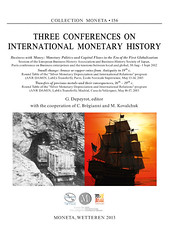 Moneta 156, Three Conferences on International Monetary History, Business with Money: Monetary Politics and Capital Flows in the Era of the First Globalization
(2012), Small change: bronze or copper coins from Antiquity to 19th c. (2013), Transfers of precious metals and their consequences, 16th - 19th (2013),G. Depeyrot, editor with the cooperation of C. Brégianni and M. Kovalchuk, 2013, 474 p. ISBN 978-94-91384-24-0
http://www.moneta.be/volumes/moneta_156.htm
Moneta 156, Three Conferences on International Monetary History, Business with Money: Monetary Politics and Capital Flows in the Era of the First Globalization
(2012), Small change: bronze or copper coins from Antiquity to 19th c. (2013), Transfers of precious metals and their consequences, 16th - 19th (2013),G. Depeyrot, editor with the cooperation of C. Brégianni and M. Kovalchuk, 2013, 474 p. ISBN 978-94-91384-24-0
http://www.moneta.be/volumes/moneta_156.htm
Moneta 158, Documents and Studies on 19th c. Monetary History, International Monetary Conferences, Conférence monétaire internationale, avril - mai 1881, Procès-verbaux (Paris, 1881) , G. Depeyrot ed., 2013, VI+354+3* p. ISBN 978-94-91384-26-6 http://www.moneta.be/volumes/moneta_158.htm
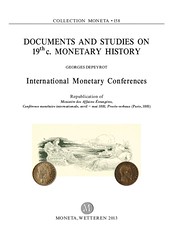 Moneta 159, Documents and Studies on 19th c. Monetary History, International Monetary Conferences, Conférence monétaire internationale, juin - juillet 1881, Procès-verbaux
(Paris, 1881), G. Depeyrot ed., 2013, VII+238+3* p. ISBN 978-94-91384-27-1
http://www.moneta.be/volumes/moneta_159.htm
Moneta 159, Documents and Studies on 19th c. Monetary History, International Monetary Conferences, Conférence monétaire internationale, juin - juillet 1881, Procès-verbaux
(Paris, 1881), G. Depeyrot ed., 2013, VII+238+3* p. ISBN 978-94-91384-27-1
http://www.moneta.be/volumes/moneta_159.htm
Moneta 160, Documents and Studies on 19th c. Monetary History, International Monetary Conferences, Republication of Translation of the Procès-verbaux of the Paris International Monetary Conference of 1881 (London, 1881), Correspondence with the India Office on the subject of the Conference (London, 1881), G. Depeyrot ed., 2013, X+236+6* p. ISBN 978-94-91384-28-8 http://www.moneta.be/volumes/moneta_160.htm
Moneta (Wetteren, Belgium) publishes volumes on numismatics, monetary history, coin finds, from Antiquity to present times, in various languages. Catalogue on www.moneta.be .
The series Documents and Studies on 19th c. Monetary History is linked to the DAMIN program on Silver monetary depreciation and international relations www.anr-damin.net
Next volumes: Trouvailles et trésors monétaires en Belgique volume XVII (Moneta 161), volume XVII (Moneta 162).

Rare U.S. & Worldwide Banknotes, Scripophily and Autographs
“The Copps Collection” of Colonial Stocks, Bonds, Documents & Fiscal Paper to be held in conjunction with the 3rd Annual Wall Street Coin, Currency & Collectibles Show.
Highlights include:
- From “The Copps Collection”, A 1792 U.S. Federal Bond Issued to and Signed by George Washington, this is one of three known, the other two are in an institutions, this is the first time ever at auction
- U.S. Colonial; Obsolete; Fractional; and, Large Type Notes including a high grade “Educational” Set of 3 notes along with dozens of other rare banknotes.
- Worldwide Banknotes including an outstanding U.A.E. Specimen Set as well as hundreds of other rare and desirable notes.
- Hundreds of U.S. & Worldwide Stocks and bonds including autographed certificates and autographs by Daniel Drew; Thomas Edison; Buffalo Bill Cody, Robert Morris and many others.

1580 Lemoine Avenue, Suite #7
Fort Lee, NJ 07024
Phone: 201-944-4800
Email: info@archivesinternational.com
WWW.ARCHIVESINTERNATIONAL.COM
BOOK REVIEW: OPHTHALMOLOGIA OPTICA ET VISIO IN NUMMIS
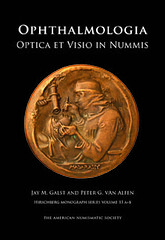 Jay M. Galst and Peter G. van Alfen, Ophthalmologia Optica & Visio in Nummis – Hirschberg History of Ophthalmology Supplement Series 13 (Paraguay: J.-P. Wayenborgh Verlag and New York: American Numismatic Society, 2013). ix + 562 pp. $285.
Jay M. Galst and Peter G. van Alfen, Ophthalmologia Optica & Visio in Nummis – Hirschberg History of Ophthalmology Supplement Series 13 (Paraguay: J.-P. Wayenborgh Verlag and New York: American Numismatic Society, 2013). ix + 562 pp. $285.
This stupendous volume is a full-dress topical catalog, virtually an encyclopedia, of some 1,700 items at the intersection of the human eye and numismatics, broadly defined to include everything from the expected medals, coins, tokens and paper money to some objects which just may lie outside even the broadest definition of “numismatic,” like convention badges and a spectacles-shaped political campaign pin. Many hundreds of these 1,700 objects are drawn from Galst’s own incredible collection, but the authors have also scoured a wide range of museums, private collections and publications for entries to enhance coverage of the topic.
Unlike the usual coin catalog which can be easily organized by date and denomination, from Afghanistan to Zimbabwe, the organization of a comprehensive, some might say sprawling, topical catalog like this one presents a challenge. Galst and van Alfen have been lucky to be able to adopt the organizational arrangement of their philatelic spiritual ancestor, F.C. Blodi’s The Eye, Vision and Ophthalmology on Postage Stamps (1986).
We are presented, therefore, with 14 chapters ranging from the expected, like “Ophthalmologists,” “Spectacles Depicted as an Optical Instrument or Depicted as a Symbol,” and “Coins, Tokens and Medals for the Blind (Braille Inscriptions)” to the unexpected, my favorite being the chapter on “The One-Eyed,” with 72 items ranging from a gold stater of Philip II of Macedonia through Theodore Roosevelt medals to a Franklin Mint piece depicting Moshe Dayan. Can it be that no numismatic object depicts a Cyclops? I didn’t see one.
It is the unexpected which makes browsing in the volume a series of epiphanies, as the symbolic light bulb over your head repeatedly lights up when you realize why this, that, or the other object qualifies for inclusion in Ophthalmologia Optica & Visio in Nummis (for the uninitiated: Ophthalmology, Optics, and Vision in Numismatics).
The word “encyclopedic” comes to mind because there is so much scholarly research crammed into and between the catalog entries. There are scores of short historical essays, literally hundreds of capsule biographies, and, where appropriate, mini-histories of eye care and eye science.
Especially valuable are the hundreds of biographies of medalists and designers which are interspersed throughout the text and then indexed in a separate “Artist Index.”
To read the complete article, see: Numismatic Work Catalogs Eye-Related Items (www.numismaster.com/ta/numis/Article.jsp?ad=article&ArticleId=27247)
To read an earlier E-Sylum article, see: NEW BOOK: OPHTHALMOLOGIA OPTICA ET VISIO IN NUMMIS (www.coinbooks.org/esylum_v15n40a04.html)
BOOK REVIEW: AMERICAN SILVER EAGLES, 2ND EDITION
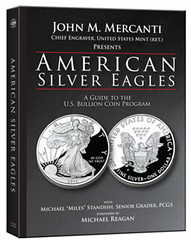

It seems like yesterday that John Mercanti's book on the U.S. bullion silver eagle coins was published. Then we blinked and there was a 2nd edition. What happened? Well, as Dennis Tucker noted in the press release for the second edition,
“If any numismatic book has earned the title of ‘runaway best-seller,’ it’s American Silver Eagles. The first edition sold out in a few months, with tens of thousands of copies eagerly snapped up by enthusiastic coin collectors and investors.”
I have to admit I was surprised by this development, but it was a pleasant surprise. I enjoyed the first edition of the book, and appreciated the behind-the-scenes narrative from the former Chief Engraver, which elevated the book from a mere guide to issues, grades and prices. It's a pretty good read, and I hope the popularity of this title builds a receptive audience for Mercanti's anticipated biography. These first-person tales from the trenches are what bring numismatic history alive.
(And yes, I know there is controversy over whether Mercanti was or wasn't officially assigned the title of Chief Engraver, but it says so on the book's cover, so I'll go with it. Title aside, as one of the most prolific and longest-serving Mint sculptor-engravers (who lead the team into the 21st century with computer-based technology), Mercanti clearly filled that role for years in practice, if not by title).
The 2nd edition naturally extends its coverage into 2012 and 2013 issues, and updates grading population figures and pricing. But there's more for researchers and bibliophiles to enjoy as well - additional research and more photographs are included.
Although the researcher and ephemera collector in me liked the image of FDR's May 1, 1933 gold bullion Executive Order that opened Chapter 1 in the first edition, I like even better the photo of President Reagan signing the Liberty Coin Act in 1985 which was substituted in the 2nd edition. The Executive Order wasn't lost - it was made smaller and moved to the page with Roosevelt's photo.
Similarly, a full-page photo of President Reagan was made smaller and moved to make way for a nice image of a bas-relief sculpture of Reagan by Mercanti. Pictures of engravers A. A. Weinman and Gilroy Roberts have been added as well.
In short, if you missed out on the First Edition, be sure to get a copy of the Second. It's nicely done and has plenty of great content to satisfy those looking for historical background in addition to the bread-and-butter listings essential to catalogs like these.
To read the earlier E-Sylum article, see: NEW BOOK: AMERICAN SILVER EAGLES, 2ND EDITION (www.coinbooks.org/esylum_v16n29a05.html)
CATALOG REVIEW: SPINK'S SALEM SALE OF AFRICAN PAPER MONEY
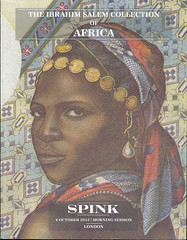
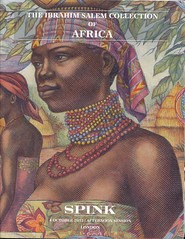
A few auction catalogues deserve a place in all numismatic libraries. Spink’s two volume set for their up-coming Ibrahim Salem paper money collection of Africa is one such.
When I picked it up at my new post office the clerk was impressed enough by its weight to comment. When I unwrapped the parcel on my desk it first appeared no more than another solid professional sale catalogue, albeit one from the hands of that Master Hunter-Gatherer, Barnaby Faul. Then I opened it. It is different. All those responsible for its compilation deserve high praise.
It is a record of the notes issued throughout Africa, country by country, as illustrated by the holdings of the comprehensive Salem collection. A summary is given for each country that provides the context surrounding the issue of its notes. And those illustrations are superb, the formatting and layout top drawer. Reading it was a fascination and a pleasure. I learned much.
I don’t collect Africa and have no intention of starting but I do know that the Salem catalogue has already slotted into the shelves of my small paper money library. It sits there most comfortably. If nothing else it will be an invaluable reference work. I recommend that all numismatic bibliophiles who have not already obtained a copy do so forthwith. You will not be disappointed.
To view the online catalog, see: The Ibrahim Salem Collection of African Banknotes (www.spink.com/auction.aspx?id=13037)
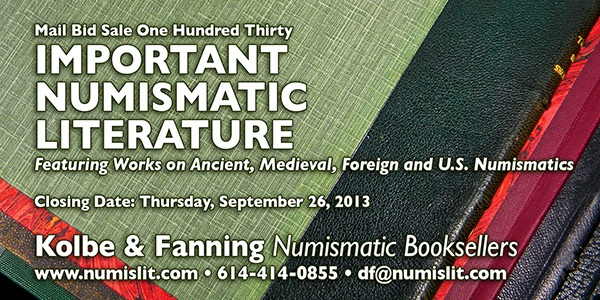
JAMES C. SPILMAN, 1926 - 2013
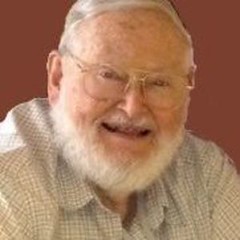 James C. Spilman, 86, of Huntsville AL, went to heaven on August 19, 2013. He was preceded in death by his son Leonard Spilman. Survivors include his wife of 64 years, Lavinia; son Bill (Barbara) of Germantown, TN; daughter Nancy Cooper (Randy) of Littleville, AL; 5 grandchildren and 3 great-grandsons.
Mr. Spilman was a great writer and was editor of the Colonial Newsletter for many years.
James C. Spilman, 86, of Huntsville AL, went to heaven on August 19, 2013. He was preceded in death by his son Leonard Spilman. Survivors include his wife of 64 years, Lavinia; son Bill (Barbara) of Germantown, TN; daughter Nancy Cooper (Randy) of Littleville, AL; 5 grandchildren and 3 great-grandsons.
Mr. Spilman was a great writer and was editor of the Colonial Newsletter for many years.
To read the complete article, see: Mr. James C. Spilman (valhalla.tributes.com/our_obituaries/James-C.-Spilman-96296132)
Ray Williams, past president of the Colonial Coin Collectors Club writes:
Al Hoch started The Colonial Newsletter and Jim took it over shortly after its founding. He was instrumental in promoting colonial research as editor of CNL for decades. I hope that future generations of colonial collectors remember him for all the knowledge we have due to his dedication, research and selfless hard work.
VIRTUAL BOOK SIGNING 'ABRAHAM LINCOLN, BEYOND THE AMERICAN ICON'
My virtual signing for my recent book Abraham Lincoln, Beyond the American Icon at the Abe Lincoln Book Shop in Chicago last month is now posted on the web. E-Sylum readers want to check it out at http://virtualbooksigning.net/recent-signings/ .
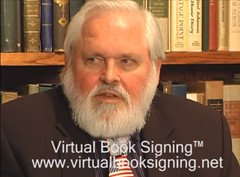 This is the second of these that I have done. The first one, you may remember, was after my first Abe Book came out. This time, however, I was the only author and had the stage to myself.
This is the second of these that I have done. The first one, you may remember, was after my first Abe Book came out. This time, however, I was the only author and had the stage to myself.
The taping was about an hour and has been broken down into four bite-sized segments on the web. Book shop owner Dan Weinberg interviewed me about my books, and we discussed various numismatic aspects of Lincoln's legacy, and other artifacts the book shop was displaying.
The "book shop," in addition to thousands of titles for sale, is a virtual museum of Lincoln and the Civil War. Many of these objects are also for sale.
A live audience of about a dozen, and more than 100 people on the internet viewed the program live. Dan said this was a good turnout for a summer broadcast.
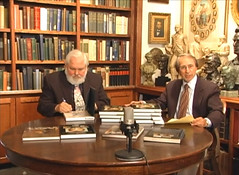 I was amazed to learn that viewers included watchers in Europe and Australia (and it was the middle of the night there!)
I was amazed to learn that viewers included watchers in Europe and Australia (and it was the middle of the night there!)
I'm not a natural interview subject, but the interviewer and I have a good rapport, since I have been visiting the store for at least 30 years when I am in Chicago, and have purchased some of my most significant Lincolniana there.
After the taping, we did a second 20 minute taping for a show called "Artifact Whisperer" but that is not posted yet, and I do not know what will be the final disposition of that tape.
It was a great experience once again. I highly recommend to other numismatic authors that they seek out such situations. It is great to meet readers, and have a chance to "show off" one's new book in this way. It's kind of like "show and tell" in grade school, but on steroids.
To view the interview on YouTube, see: Reed Part 1 (www.youtube.com/watch?v=vItDhl_UHoU&list=PLJuQydXCivgo4p1viEeThHnyMqgrmJe53)
NOTES FROM E-SYLUM READERS: SEPTEMBER 22, 2013
Kudos for Paul Torongo's Medieval Book
Bob Fritsch writes:
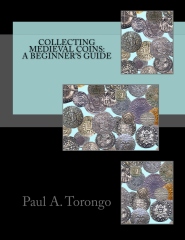 To add to the CreateSpace dialog, I was talking to an author friend about the controversy. He said that he uses it at a modest cost for his mystery novels, but the price goes up exponentially if a lot of pictures are part of the manuscript.
To add to the CreateSpace dialog, I was talking to an author friend about the controversy. He said that he uses it at a modest cost for his mystery novels, but the price goes up exponentially if a lot of pictures are part of the manuscript.
I ordered the book from Amazon at the reduced price and got it within a few days. It is magnificent! While I do not collect medieval coins, I enjoy reading about all aspects of the hobby. This volume deserves an honored place in any numismatic library. Kudos to Paul Torongo for an epic work.
To read the earlier E-Sylum article, see: MORE ON CREATESPACE AND AMAZON PRICING (www.coinbooks.org/esylum_v16n38a12.html)
The Hong Kong Plague of 1894
Paul Bosco caught a typo in the article on Jerome Platt's new book. The reference to
“The Hong Kong Plague of 1984. “ should be
“The Hong Kong Plague of 1894. “.
Thanks. I checked with Jerry, and fortunately the information on the slipcase of the book (where the text was taken from) is correct.
To read the earlier E-Sylum article, see: NEW BOOK: THE ENGLISH CIVIL WARS (www.coinbooks.org/esylum_v16n38a07.html)
The Alan M. Meghrig Library
Last week Mike Paradis submitted an excerpt from the June 7, 2007 Kolbe sale 103, lot 255.
NUMISMATIC TIMES AND TRENDS. VOLUME I, NUMBER 1- VOLUME I, NUMBER 22. New Orleans, January 10-November 25, 1961. 658 pages, illustrated. (bound with) COINS MAGAZINE. VOL. IX, NO. 1. Iola, January 1962. 46, (2) pages, illustrated. Quarto. Black cloth, gilt. Fine.
George Kolbe writes:
The above appeared in the second part of the Alan M. Meghrig Library and was quite representative of the consignor's extensive and eclectic holdings. Alan's library was and is extremely rich in obscure American numismatic publications not to be found elsewhere and it was my great privilege and pleasure to have catalogued and sold parts of it.
To read the earlier E-Sylum article, see: MORE ON 'NUMISMATIC TIMES AND TRENDS' (www.coinbooks.org/esylum_v16n38a10.html)
Magazine Search Follow Up
Regarding last week's compilation of web sites for searching magazines, Fred Michaelson writes:
Wayne, David, Ron, and Dave: Thanks so much for your help! I appreciate it this much. (I'm holding my hands far apart.)
To read the earlier E-Sylum article, see: WEB SITES FOR OLD MAGAZINES (www.coinbooks.org/esylum_v16n38a13.html)
Coins with Images of Books
Pabitra Saha forwarded these images of Hungary's new coin honoring the 200th Anniversary of the birth of József Eötvös, a Hungarian writer and statesman. We numismatic bibliophiles love books about coins, but here's a switch - a book on a coin itself.

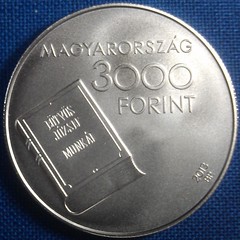
The reverse is awful (awfully plain, anyway), but makes me wonder - what other coins out there picture books?
Biggest coin ever?
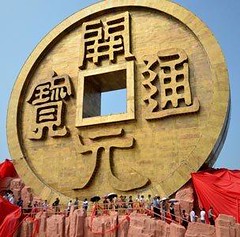 Jim Neiswinter writes:
Jim Neiswinter writes:
Biggest coin ever?
I think we discussed this sculpture in China resembling a giant cash coin, but I was unable to locate the article in our archive. Jim found it on the MSN home page Wednesday. Thanks!
Brenner Motherhood Medal
It's too late for Mother's Day, but this Brenner medal caught my eye in Joe Levine's Presidential Coin & Antique Company 61st Mini Fixed Price List of Tokens and Medals. (I checked with Joe, and this one's been sold already).
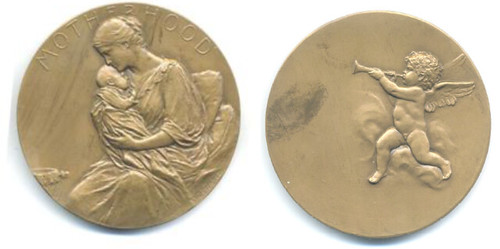
CIRCLE OF THE FRIENDS MEDAL BY BRENNER, 1911. Alexander COF 4.1. Smedley 87; Baxter 140; Marqusee 70. 69.9mm. Bronze. Victor D. Brenner. (Davison) Uncirculated, with the usual splotchy finish that appears on almost of Davison medals. Obverse: MOTHERHOOD at top above a seated woman left holding a baby whose head is on her left shoulder. Reverse: Winged cherub on cloud facing left blowing a trumpet. The medal is housed in the die cut page of its original hard cover book which contains an essay on Motherhood and a brief biography of Brenner. The book is in average condition.
THE BOOK BAZARRE
QUERY: NATIONAL COIN ALBUM ROMAN COIN PAGES SOUGHT
Larry Korchnak writes:
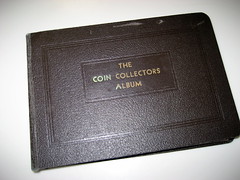 Thank you for including David Lange's information in The E-Sylum. After David's earlier article, I contacted him to ask about the National Coin Album pages that I have for Roman Coins (500A through 500F). He confirmed that the pages are listed in his soon to be published catalog, but he did not have photos to show. I sent him photos of the pages; however, they were too late to add to the catalog. I wonder how many other sets are out there?
Thank you for including David Lange's information in The E-Sylum. After David's earlier article, I contacted him to ask about the National Coin Album pages that I have for Roman Coins (500A through 500F). He confirmed that the pages are listed in his soon to be published catalog, but he did not have photos to show. I sent him photos of the pages; however, they were too late to add to the catalog. I wonder how many other sets are out there?

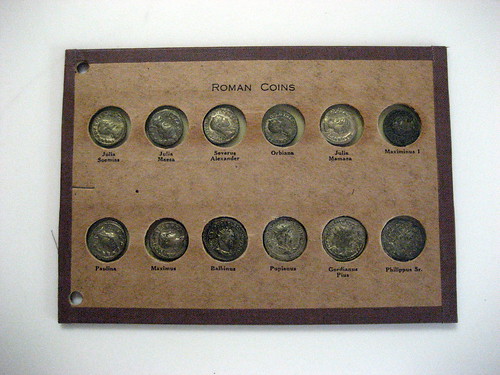
Larry adds:
The boards have spaces for emperors from Pompei the Great to Postumus. I completed the collection even though there are holes for non-emperors, i.e. Nero Claudius Drusus and Cleopatra VII.
To read the earlier E-Sylum articles, see:
NOTES FROM E-SYLUM READERS: SEPTEMBER 15, 2013 : National Coin Album Books Forthcoming
(www.coinbooks.org/club_nbs_esylum_v16n38.html)
NEW BOOK: COIN COLLECTING ALBUMS, VOLUME ONE
(www.coinbooks.org/esylum_v16n32a02.html)
QUERY: INPUT FOR NEW SMITHSONIAN NUMISMATIC EXHIBIT SOUGHT
Karen Lee of the National Numismatic Collection writes:
We’ve started to design a new exhibition tentatively called “The Value of Money” which will be a permanent (20 year) collection gallery for the NNC. The design firm is Britain's Haley Sharpe Design—they’re also designing the American Enterprise (business history) exhibition that will be our neighbor on the museum floor.
If E-Sylum readers have suggestions for themes or must-see objects, we are willing to entertain suggestions--- we're curious about what the top three must-see objects would be.
What a challenge to narrow picks to just a few! I'll be equally curious to learn what E-Sylum readers suggest. Many of you are very familiar with the collection, having been there for research.
 Here is an 1838 gold sovereign, which may have been one of those used to convey James Smithson's bequest to the United States for the creation of the Smithsonian Institution.
I think my own votes would veer toward the earliest coinage of our nation, such as 1791 Washington cents, a 1792 Half Disme or the 1794 copper pattern dollar. Some of the most important early U.S. coins aren't in the collection, though, like the 1783 Nova Constellatio Silver pattern set. I'd also love to see the Thian albums of Confederate currency, an original Confederate currency printing plate, or George Morgan's sketchbook. But where to stop? I'd rather see it all!
Here is an 1838 gold sovereign, which may have been one of those used to convey James Smithson's bequest to the United States for the creation of the Smithsonian Institution.
I think my own votes would veer toward the earliest coinage of our nation, such as 1791 Washington cents, a 1792 Half Disme or the 1794 copper pattern dollar. Some of the most important early U.S. coins aren't in the collection, though, like the 1783 Nova Constellatio Silver pattern set. I'd also love to see the Thian albums of Confederate currency, an original Confederate currency printing plate, or George Morgan's sketchbook. But where to stop? I'd rather see it all!
Anyway, I'll look forward to reader suggestions, and will compile them for the next issue (and pass them along to Karen). Thanks! Remember, we're looking for overarching themes and just one to three object nominations from each reader. Choose thoughtfully!
SMITHSONIAN NATIONAL POSTAL MUSEUM GROSS GALLERY OPENS
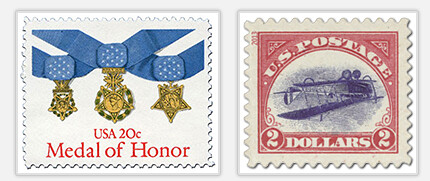
The Smithsonian’s National Postal Museum opens its new William H. Gross Stamp Gallery to the public Sunday, Sept. 22. Named after its primary benefactor, it is the world’s largest stamp gallery and the only one to show stamps and mail in the context of American history and culture. It provides an experience available nowhere else and offers something for everyone—from casual visitors to experienced collectors.
Among the gems on display: a cover postmarked on the moon in 1971; a watch worn by a sea clerk aboard Titanic; one of two 1868 1-cent Z-grill stamps in existence (with the image of Benjamin Franklin, the nation’s first postmaster general); a letter addressed to John Hancock postmarked July 4, 1776; stamps depicting kings of Hawaii before it became a state; and the icon of the Smithsonian’s stamp collection—the Inverted Jenny—will be shown along with other stamps from America and around the world.
A wall of exterior windows overlooking Massachusetts Avenue, depicting reproductions of 54 historic U.S. stamps, provides a dramatic nighttime glow and is a preview of what is inside the museum’s 12,000 square feet of new exhibit space. Special family activities, tours and programs will be offered throughout the day; from 10 a.m. until 5:30 p.m.
To read the complete article, see: World's largest stamp gallery opens at the National Postal Museum (artdaily.com/news/65140/World-s-largest-stamp-gallery-opens-at-the-National-Postal-Museum#.Uj435Maa7C8)
For more information on the galley, see: National Postal Museum (www.postalmuseum.si.edu/)

FORT MCHENRY QUARTER LAUNCH CEREMONY REPORT
On September 13th, 2013, various dignitaries, along with hundreds of Maryland elementary and middle school children, met on the grounds of Fort McHenry in Baltimore, Maryland to launch the Fort McHenry National Monument and Historic Shrine “America the Beautiful” quarter dollar. The launch was timed to coincide with the 199th anniversary of the attempt by the British Navy to invade Baltimore by way of the Chesapeake Bay, and began a weekend-long event commemorating Defender’s Day in Baltimore. During the event, I was seated near several current and former members of the Maryland State Numismatic Association (MSNA), including MSNA President Frank Murphy, as well as U.S. Mint Deputy Director Richard Peterson.
The event was led by Master of Ceremonies James C. Bailey, one of the park rangers stationed at the shrine. Also in attendance was Fort McHenry National Monument and Historic Shrine Superintendent Tina Cappetta, U.S. Senator Ben Cardin of Maryland, U.S. Representatives John Sarbanes and Dutch Ruppersberger (representing Maryland’s 3rd and 2nd Districts, respectively), Baltimore Mayor Stephanie Rawlings-Blake, and Rosie Rios, Treasurer of the United States, who each made speeches about the importance of the fort to the nation during the War of 1812, and of how the events of that battle shaped our national anthem, written by Francis Scott Key while he was detained on board the British ship HMS Tonnant. A delegate from U.S. Representative Elijah Cummings’ office was also in attendance, as the congressman was unable to attend in person.
Treasurer Rios said, “The defense of Fort McHenry was the watershed event in the War of 1812, and this new quarter captures the significance of that victory and connects all Americans who use it to Fort McHenry and its honored place in American history.”
After the official ceremony, the school children were each given one uncirculated Fort McHenry quarter, handed out by Senator Cardin, and Representatives Sarbanes and Ruppersberger, among others. In addition, a local bank had set up a tent with tellers who would exchange currency for rolls of the new quarters, up to $100 per person. I obtained one roll, then drove to the nearest U.S. Post Office to have it postmarked to certify that it was from the ceremony.
To read the complete article, see: Fort McHenry National Monument and Historic Shrine Quarter Launch Ceremony (news.coinupdate.com/fort-mchenry-national-monument-and-historic-shrine-quarter-launch-ceremony-2155/)
MORE ON THE VALUE OF A MEDAL OF HONOR
Last week’s article titled “What is the value of a Medal of Honor?” was more than just an interesting diversion for me. Although the original Forbes article was a bit vague on the states where the key players in the story resided, due to its name I correctly guessed that the Pejepscot Historical Society is located in Maine, and I was absolutely certain that the town of Duxbury where the medal was found is the Massachusetts town where I grew up.
The First Parish Church Fair where the Civil War-era Medal of Honor medal was found is an annual summer event that has probably been held since the beginning of time. I remember many years ago picking up a large 19th century engraving for $1 and on another occasion finding a first edition of “Six Crises”, Richard Nixon’s first book, for 50 cents or maybe a dollar; I am sure that similar bargains are still to be had, perhaps with a slight adjustment for inflation. Although I live only a couple towns away I have not made it to the fair in recent years, mainly due to the fact that the real action seems to occur earlier than I can accommodate on a Saturday morning. I am torn between pride in my hometown being the source of this lost treasure, and the knowledge that maybe I could have been the one to discover it.
A little research confirms that the questions about the value of a Medal of Honor and whether or not one can be sold are complicated matters with little reliable precedent. It is clearly legal to own a MOH, but perhaps not to sell it. It is, however, apparently legal to gift a MOH. In the case of the MOH stashed away in a book that was sold at the church fair, I would contend that the seller and buyer were dealing in the book itself and the medal was an unknown and unexpected bonus (I am still not sure how you can stash a medal in a book and not notice it a mile away, but the Forbes story did not address those difficult logistics). In that scenario, the MOH was a gift or perhaps found or abandoned property that had been transferred without any financial consideration.
If a dollar value had to be assigned to a MOH, I wouldn’t even know where to start. This MOH was from the Civil War, and almost half of all MOHs ever bestowed were awarded during that conflict. At that time it was the only decoration for valor available, and the qualifications were obviously less stringent as evidenced by the fact that hundreds were rescinded in the early 20th century when a review of all previous Medals of Honor was undertaken to identify those that were awarded for any reason other than “distinguished service”. All of this would seem to somewhat diminish the importance of a Civil War MOH, but then again, the MOH awarded to Joshua Chamberlain was for his actions in an important battle at Gettysburg.
There was allegedly an auction in recent years of the presentation box and certificate that accompany a MOH (those can be sold without restriction), and after the auction the MOH itself was “gifted” to the high bidder; that auction supposedly ended at just under $30,000. Even if this unattributed anecdote found on the Internet is accurate, there are so few, if any, comparables that it would seem impossible to confidently assign a monetary value to a Medal of Honor, assuming a transaction convoluted enough to circumvent the relevant laws could be devised.
To read the earlier E-Sylum article, see: WHAT IS THE VALUE OF A MEDAL OF HONOR? (www.coinbooks.org/esylum_v16n38a21.html)
MEDAL OF HONOR SOCIETY HOLDS 2013 CONVENTION
The autograph hounds waiting expectantly in a hotel lobby weren't drawn by actors, musicians or politicians, but by a few dozen men whose rare and distinguished achievements have earned them the nation's highest military honor.
Nearly half of the 79 living recipients of Medal of Honor are attending the gathering in Gettysburg, where some of its first recipients fought 150 years ago.
The Medal of Honor Society annual convention gives the public an opportunity to collect the signatures of the men who have been honored by Congress for risking their lives beyond the call of duty in combat, and dozens of people waited Thursday for them to return from a luncheon at a nearby farm once owned by President Dwight Eisenhower.
Dave Loether, 62, a computer analyst from Pittsburgh, was hoping to add to the 55 signatures of Medal of Honor recipients he has collected on a U.S. Army flag. Loether knows many of their faces by sight — and their stories by heart.
"It's a piece of cloth with some ink on it — it's worthless," Loether said. "On the other hand, it's priceless."
The recipients' autographs sometimes end up on public auction sites, but Loether said he collects them as a hobby that began as a way to honor his sons in the military.
Recipients sat at tables ringing a hotel ballroom, including Clinton L. Romesha, of Minot, N.D. President Barack Obama presented him with the honor in February for bravery in defending an Army outpost in Afghanistan four years ago.
Now working in safety for a construction company, Romesha, 32, said he tries to remind himself that he's still the same person he was before, a man who has to take out the trash himself.
"I never thought in a million years I'd ever meet a recipient, let alone be one," said Romesha, who was attending his first convention.
Eight soldiers died in the daylong barrage by the Taliban in the mountains near Pakistan, and Romesha was one of 22 wounded among the badly outnumbered Americans. He helped lead others to safety and retrieve the bodies of the U.S. dead.
To read the complete article, see: War hero 'groupies' follow trail to Gettysburg (www.wday.com/event/article/id/87175/group/homepage/)
THE BOOK BAZARRE
QUERY: WHAT IS A SPINNERET MACHINE?
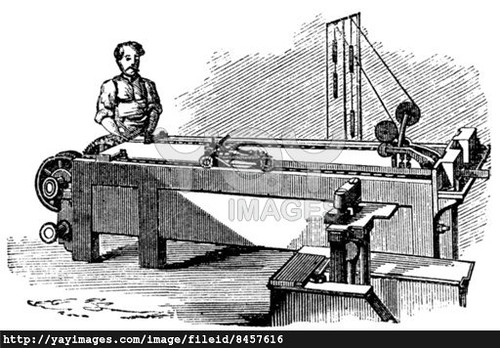
A web site visitor writes:
I'm reading some facts about the 1804 dollar. Are you familiar with the spinneret machine?
BANK OF ENGLAND STIFLES REQUEST FOR NAME OF BANKNOTE ALTERNATES
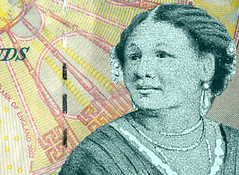 The Bank Of England has refused to reveal the two other figures it considered featuring on banknotes instead of Jane Austen and Winston Churchill.
The Bank Of England has refused to reveal the two other figures it considered featuring on banknotes instead of Jane Austen and Winston Churchill.
After a Freedom of Information request from the Huffington Post UK, the Bank disclosed that "two other candidates" were considered by officials in April 2012, when they chose Churchill and Austen as "contingency characters" for future print runs of UK banknotes.
The Bank revealed in April that Churchill would start featuring on UK £5 banknotes from 2016, while then governor Mervyn King told MPs that Austen was "waiting in the wings" to be featured on UK £10 banknotes. The decision to include the 19th century author on £10 banknotes from 2017 was confirmed by King's successor Mark Carney this June.
Banknote campaigners have called for greater female representation. Labour leader Ed Miliband said in June: "Why don't we have one of our great women scientists like Elizabeth Garrett Anderson and a suffragette like Emmeline Pankhurst on our banknotes?"
Despite the rush of banknote announcements, Bank Secretary John Footman directed bank officials to avoid revealing the identity of the other two candidates in order to protect the "free and frank provision of advice".
"The decision as to the design of a banknote rests with the Governor upon advice from amongst others the Chief Cashier and Notes Division, and is guided, among other things by suggestions from members of the public, which the Bank encourages and publishes on its website. Inevitably publication of the remaining names on the 2012 shortlist would create a presumption in the public mind that these would be the next to appear on a banknote, and that the Bank's mind was therefore closed to further suggestions," the Bank said.
To read the complete article, see: Bank Of England Refuses To Name Mystery Alternatives To Jane Austen Banknote (www.huffingtonpost.co.uk/2013/09/17/bank-of-england-banknote_n_3940000.html)
ARTICLE DISCUSSES MARKET FOR FANCY SERIAL NUMBERS
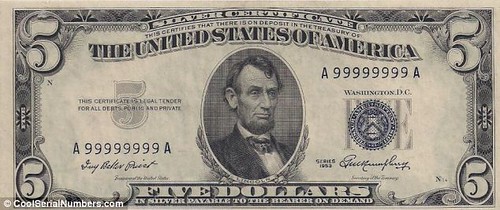
The next time you're holding a dollar bill, it might be worth looking further than the big number one - you could get more bang from your buck than you expected. Ordinary low denomination bills are raking in thousands of dollars in an online trend that is centred on the eight-digit serial number which appears on each U.S. banknote.
'Unusual' bills are being bought, sold and hunted on the website CoolSerialNumbers.com, with low serial numbers, from 00000001 to 00000100, being particularly sought after, a $1 bill with the serial number 00000002 going for $2,500.
The U.S.-based site lists all the different notes that collectors are looking out for and allows serial number fans to get in touch with one another.
There are categories such as 'solids' (where the digits repeat eight times), 'ladders' (12345678), 'radars' (01133110 - where the number reads the same left-to-right as right-to-left) and 'repeaters' (20012001 - the second half is the same as the first half).
Then there are 'radar repeaters' (12211221), 'super radars' (20000002 - all the internal digits are the same) and 'super repeaters' (where the first two digits are repeated four times, such as 63636363).
Dave Undis, the a Nashville musician and currency collector who runs the site, is happy to include some criteria that might go unnoticed to the untrained eye - such as a 'pi note' with the number 31415927.
A $5 bill with the number 33333333 is currently up for sale for $13,000, while a set of nine $20 bills running from 00000010 through to 00000090 can be bought for $1,800.
Collectors have long been interested in rare and flawed money - and not just in the U.S.
In September last year, the Bank of England auctioned £5, £10, £20 and £50 notes with unusual serial numbers - such as those coming at the beginning or the end of a run, often characterised by the prefix A01.
To read the complete article, see: Is your dollar bill worth thousands? The bizarre trend for collecting cash with ‘interesting’ serial codes (www.dailymail.co.uk/news/article-2423315/Dollar-Serial-numbers-make-banknotes-worth-thousands-online-trend.html)
To read the complete article, see: For serial-number hunters, $100 isn’t just $100 (www.boston.com/2013/09/15/dollars/C0qw9KcJvAmWwGyVWqREOJ/singlepage.html)
THE BOOK BAZARRE
QUERY: WHOSE NUMISMATIC LIBRARY DID BLUESTONE SELL IN 1947?
Last week's issue was great as usual. I was especially interested to read about the Quarto Attinelli that Tom Elder sold in 1932. I pulled my catalog of this sale to check it out, and found the Attinelli was in a consignment from the S. Hudson Chapman estate. To any of our readers who have this catalog, the books and plated catalogs will make you drool. Of course in 1932 most people were using their money to buy bread rather than numismatic literature.
If you are searching for an item sold by Elder, it is not an easy task. His catalogs are not indexed, and each consigner's items are separate. If four people consigned large cents, they will be in four different places in the catalog. Years ago I saw a rare Charleston Social Club medal sold in one of Elder's sales, but now cannot remember which sale I saw it in.
Speaking of Elder, I recently purchased some issues of Hobbies magazine. In the Oct, 1947 issue Elder writes of a huge numismatic literature library to be sold by Barney Bluestone. Hundreds of rare plated catalogs of the Chapmans, Elder, Proskey, Leavitt, and others. He does not say who was the owner of the library. Apparently these were sold in Bluestone's 98th & 99th sales in Oct & Dec 1947. I don't own these catalogs, but perhaps someone can give us some of the highlights.
To read the earlier E-Sylum article, see: ELDER SOLD LARGE-PAPER VERSION OF ATTINELLI’S NUMISGRAPHICS (www.coinbooks.org/esylum_v16n38a15.html)
NATIONAL BANK OF CAMBODIA PLANS MONEY MUSEUM
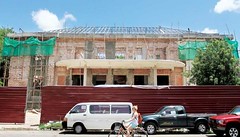 In January, officials broke ground on the new $4 million headquarters for the Cambodia Securities Exchange. Situated along a northern stretch of Freedom Park, a short skip from Wat Phnom, the French colonial-era building is a suitable home for the two-year-old bourse, which now operates out of Canadia Tower. The site, expected to open in early 2014, used to house the Ministry of Economy and Finance.
In January, officials broke ground on the new $4 million headquarters for the Cambodia Securities Exchange. Situated along a northern stretch of Freedom Park, a short skip from Wat Phnom, the French colonial-era building is a suitable home for the two-year-old bourse, which now operates out of Canadia Tower. The site, expected to open in early 2014, used to house the Ministry of Economy and Finance.
The CSX building heralds a future of prosperity. But just next door, in a two-storey structure dating back to the 1920s, Cambodia’s first museum of money is a nod to the economic past.
Commissioned by the National Bank of Cambodia, the monetary-themed history exhibit is slated to open in 2015.
“The NBC wishes to have a museum for the benefit of the nation; especially for the benefit of young people to learn and understand the history of money and the role of the central bank,” said Nguon Sokha, director-general of the NBC. “Many central banks in the world have such kind of museums.”
Visitors will learn about the development of the riel and should be able to view currency displays from different eras of Cambodian life.
“We want [the museum] to keep old documents and show people our history of coins and bills,” said an accountant from the central bank, who declined to be named since he was not authorised to speak to the media about the project.
He said the NBC is fully funding the two-storey museum, but would not disclose the figure.
The bank employee of 25 years added that, while US dollars are commonly used in Cambodia, they won’t have a place in the exhibit. American banknotes have been the Kingdom’s default currency since the UN peacekeeping operation in 1993 pumped them into the economy, sidelining the Cambodian riel that first came on the scene after independence from France in 1953.
To read the complete article, see: Museum for money planned (www.phnompenhpost.com/business/museum-money-planned)
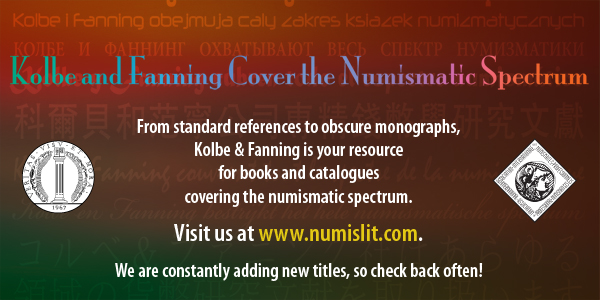
MULLIGAN MINT FILES FOR BANKRUPTCY
A Dallas mint that makes commemorative coins and “alternative” money for people who are wary of the U.S. dollar has run into problems with its own finances.
The 25-worker Mulligan Mint Inc.—which has the power to create a “complementary currency system that can fill in the blanks where the U.S. dollar lets us down,” according to its president—has filed for bankruptcy after officials in June discovered that part of a $1.4 million shipment of silver was missing.
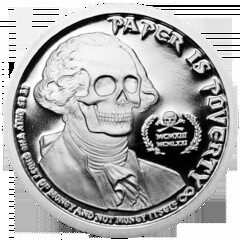 Mulligan Mint’s business targets an antiestablishment clientele who feel estranged by traditional banking; its Deluminati coin, for example, “says no to inflation, crony capitalism and all-powerful government and yes to individual liberty, economic independence and opportunity.” A Web-advertised one-ounce copper coin reflects the image of Tea Party hero and former U.S. Rep. Ron Paul, while another one asks in copper, “Who is John Galt?”
Mulligan Mint’s business targets an antiestablishment clientele who feel estranged by traditional banking; its Deluminati coin, for example, “says no to inflation, crony capitalism and all-powerful government and yes to individual liberty, economic independence and opportunity.” A Web-advertised one-ounce copper coin reflects the image of Tea Party hero and former U.S. Rep. Ron Paul, while another one asks in copper, “Who is John Galt?”
Perhaps a better question to ask Mulligan Mint executives: Where did the silver go?
“That’s the big question,” Mulligan Mint President Rob Gray told Bankruptcy Beat. “We don’t really know.”
The mint’s Chapter 11 case was filed last week to keep the silver shipment’s owner, precious metals refinery Republic Metals Corp. in Miami, from taking steps to shut down the 20,000-square-foot plant, Mr. Gray said.
Since Mulligan Mint opened last year, the mint has grown to make between 30,000 and 50,000 coins a month, Mr. Gray said. The company’s equipment, some of which came from a Denver mint that made pennies, can “melt, cast, roll, blank, rim, anneal, burnish, wash and mint” coins, according to its website.
Some of the mint’s coins are used by Native American tribes or associations that want commemorative coins. It has also sold coins for what are called “community currencies”—an alternative money system adopted by small groups of people.
To read the complete article, see: Texas Coin Maker for Fed-Estranged Files for Bankruptcy (blogs.wsj.com/bankruptcy/2013/09/20/texas-coin-maker-for-fed-estranged-files-for-bankruptcy/)
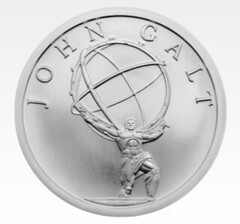
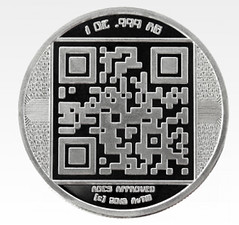
To visit the company web site, see: http://mulliganmint.com/
RARE EDWARD VIII THREE PENCE PATTERN BEING AUCTIONED
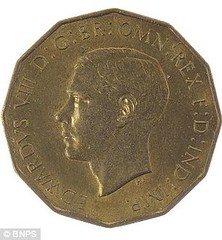
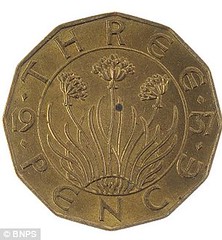
An incredibly rare coin bearing the likeness of King Edward VIII which was made before he famously abdicated his throne has emerged for sale for £30,000.
The 12-sided coin, worth just threepence when it was made, was an experimental piece produced by the Royal Mint after the death of King George V.
Edward automatically succeeded his father but abdicated before his coronation so he could marry American divorcee Wallis Simpson.
While commemorative Royal China was mass-produced to honour the new King, hardly any coins with his head on were created.
The piece now for sale was one of no more than 10 brass pattern threepence coins produced by the Mint.
The reverse has an emblem of a thrift plant and the date of 1937. Edward abdicated in December 1936 and was succeeded by his brother, King George VI.
The coin has been owned by a private collector of historic British coins for the last 20 years and he has now decided to sell it at auction.
'Edward was effectively King for a year and the Mint was a bit late in producing these coins, probably because they were experimenting with radical, art deco shapes like this one.
'This is coming from a private collector who has spent 25 years forming a large collection of English coins dating back to the 16th century.
To read the complete article, see: Thrupenny bit bearing the head of King Edward VIII before he abdicated his throne to marry Wallis Simpson on sale for £30,000 (www.dailymail.co.uk/news/article-2423152/King-Edward-VIII-Thrupenny-issued-abdication-sale-30-000.html)
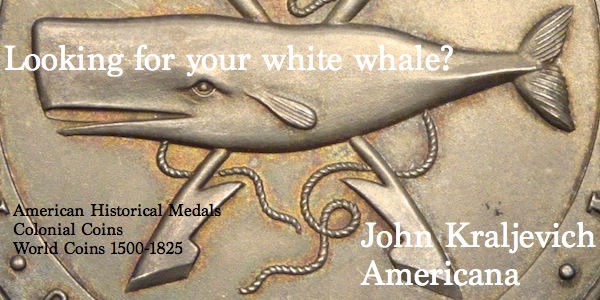
BALDWIN'S ARIELLE COLLECTION OF BRITISH COLONIAL COINS
The last of the 2013 Official Coinex Auctions will see Baldwin’s hold the first auction of coins from The Arielle Collection, one of the most impressive British Colonial coin collections to be sold by public auction. Part One will be sold on 26 September at the CIPFA Conference Centre, and explores the coins of British West Africa and East Africa, extending across the continent to Rhodesia and to Mauritius and Zanzibar in the Indian Ocean.
 This collection offers the perfect introduction to British Colonial Coins in Africa, assembled at a time when the area was relatively unexplored by many numismatists. The pinnacle of the British West Africa pieces is lot 3202, a Nickel-Brass 1928 George V 2-shilling (pictured). This uncirculated piece is a rare survivor, as it is believed that as many as 22,000,000 of these 2-shillings and shillings were melted down in 1929, following economic hardship. The rarity too of the 1928 date, and semi-prooflike condition, ensures that this is a very desirable coin and is sure to attract significant interest. The coin carries a pre-sale estimate of £6000-£8000.
This collection offers the perfect introduction to British Colonial Coins in Africa, assembled at a time when the area was relatively unexplored by many numismatists. The pinnacle of the British West Africa pieces is lot 3202, a Nickel-Brass 1928 George V 2-shilling (pictured). This uncirculated piece is a rare survivor, as it is believed that as many as 22,000,000 of these 2-shillings and shillings were melted down in 1929, following economic hardship. The rarity too of the 1928 date, and semi-prooflike condition, ensures that this is a very desirable coin and is sure to attract significant interest. The coin carries a pre-sale estimate of £6000-£8000.
The collection is further strengthened by an almost complete run of dates in the British West Africa section, any dates absent from this run are largely made up for by the high volume and quality of proofs presented. Among those offered in this sale are several complete sets including lot 3220, a George V, 1913 Double Royal Mint Proof Set, in its original box, and lot 3483, a 1932 Southern Rhodesia Uniface Reverse Proof Set, of which there are only two known. These two lots are estimated to sell for £2,000-2,500 and £3,000-5,000 respectively.
 Collectors of British Colonial Africa are spoilt for choice with the array of proofs and rarities including lot 3270, an 1818 Gold Coast Silver Pattern ½-Ackey (pictured below) of which only five examples are known. This stunning piece, in brilliant mint state, is excessively rare with only four or five other examples known. This pattern is quite distinctively different from the currency pieces. The planchet is thinner and wider at 26.6mm vs 25.3mm for the currency piece. The portrait is more in line with the English coins being produced at this time. Other differences include the placement of the denomination “1/2 TRADE ACKEY” under the bust. This lovely coin is estimated to sell for £2,000-3,000.
Collectors of British Colonial Africa are spoilt for choice with the array of proofs and rarities including lot 3270, an 1818 Gold Coast Silver Pattern ½-Ackey (pictured below) of which only five examples are known. This stunning piece, in brilliant mint state, is excessively rare with only four or five other examples known. This pattern is quite distinctively different from the currency pieces. The planchet is thinner and wider at 26.6mm vs 25.3mm for the currency piece. The portrait is more in line with the English coins being produced at this time. Other differences include the placement of the denomination “1/2 TRADE ACKEY” under the bust. This lovely coin is estimated to sell for £2,000-3,000.
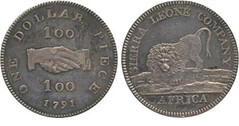 The East Africa offering boasts lot 3663, a George V pattern Silver Florin, 1921, as well as lot 3534, a rare
George V cupro-nickel cent of the same year, a date of cupro-nickel cent which was never released for circulation. Lot, 3253, a 1791 Sierra Leone Silver proof Dollar (pictured) is a standout piece from elsewhere on the continent. These three lovely lots are estimated at £3,000-5,000, £3,000-4,000 and £6,000-8,000. Lot 3694 is a very rare and extremely fine AH 1299 Gold 5-Riyals from Zanzibar with an extremely fine estimate of £8,000-10,000.
The East Africa offering boasts lot 3663, a George V pattern Silver Florin, 1921, as well as lot 3534, a rare
George V cupro-nickel cent of the same year, a date of cupro-nickel cent which was never released for circulation. Lot, 3253, a 1791 Sierra Leone Silver proof Dollar (pictured) is a standout piece from elsewhere on the continent. These three lovely lots are estimated at £3,000-5,000, £3,000-4,000 and £6,000-8,000. Lot 3694 is a very rare and extremely fine AH 1299 Gold 5-Riyals from Zanzibar with an extremely fine estimate of £8,000-10,000.
The second part of this outstanding collection will sold in London in May 2014. More details of all Baldwin’s forthcoming auctions can be found online at Baldwin’s website, www.baldwin.co.uk and the catalogue for this sale can be found at www.baldwin.co.uk/auction-83
SANTA BARBARA LUCKY PENNY RESTAURANT HAS WALL OF COINS
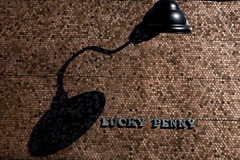 Customers of the new Santa Barbara restaurant Lucky Penny may pass by the wall tiled in real coins and be tempted to try the design stunt at home, given that it calls for a simple material that seems so cheap. But think twice, cautions its designer, Doug Washington: "It's incredibly time-consuming, tedious and hard to install."
Customers of the new Santa Barbara restaurant Lucky Penny may pass by the wall tiled in real coins and be tempted to try the design stunt at home, given that it calls for a simple material that seems so cheap. But think twice, cautions its designer, Doug Washington: "It's incredibly time-consuming, tedious and hard to install."
The fabrication of the penny wall at Lucky Penny turned out not to be for the careless or the OCD-prone. Wall assembly was a six-month community effort involving local high school students who volunteered their labor in exchange for Lucky Penny contributions to nonprofit organizations.
To create the penny tiles, coins were glued by hand onto 12-inch-square plastic mesh sheets. Those sheets then were applied to the building with epoxy mastic and thin-set mortar, just like conventional ceramic tile, Lucky Penny managing partner Sherry Villanueva says.
Designers have used penny tile to make dramatic statements before, but usually as floor tile. Real coins proved to be more challenging when used on a vertical surface. Villanueva also said the restaurant's location near the ocean was as a factor, requiring extra attention to the selection of grout and sealant.
With strong enough glue, the coins won't fall off the mesh backing, Villaneuva said, but in order for the pennies to line up and look attractive, they had to be arranged with precision. When Washington was asked to give advice to readers interested in repeating the project, he said: "Rent an entire season of some show they've never seen." This will take time.

To read the complete article, see: Lucky Penny? How about a wall of them: Copper coins as tile (www.latimes.com/home/la-lh-lucky-penny-santa-barbara-wall-tile-20130912,0,5986844.story)
SILVER DOLLARS JAM COIN COUNTER, FOILING THIEVES
The burglars got away with thousands of dollars in rare coins from a St. Paul house, but they ran into trouble when they tried to put the money through a coin machine at a bank that happened to employ the victim, according to St. Paul police.
Employees at the BankCherokee Smith Avenue branch on the city's West Side became suspicious Thursday afternoon when some teenage males wanted to exchange a sack of coins for paper money, but the coin-counting machine got jammed with rare silver dollars, said police spokesman Sgt. Paul Paulos.
Also, the teens tried this at a bank where an employee who lives on the West Side recently lost a large rare coin collection in a home burglary, Paulos said.
The bank called police, who arrested five 18-year-old St. Paul men at the bank.
To read the complete article, see: Teens' St. Paul heist foiled when silver dollars jam coin counter, police sa (www.twincities.com/crime/ci_24141664/teens-st-paul-heist-foiled-when-silver-dollars)
FEATURED WEB PAGE: SOUTH AFRICAN RAND
This week's Featured Web Page is the Wikipedia page on the South African rand.The rand is the currency of South Africa. The rand has the symbol "R" and is subdivided into 100 cents, symbol "c". The ISO 4217 code is ZAR, from Dutch Zuid-Afrikaanse rand. (South African rand). Before 1984, the Dutch language was one of the official languages of South Africa.
The rand is the currency of the Common Monetary Area between South Africa, Swaziland and Lesotho. Although Namibia withdrew from the Common Monetary Area, the rand is still legal tender there.
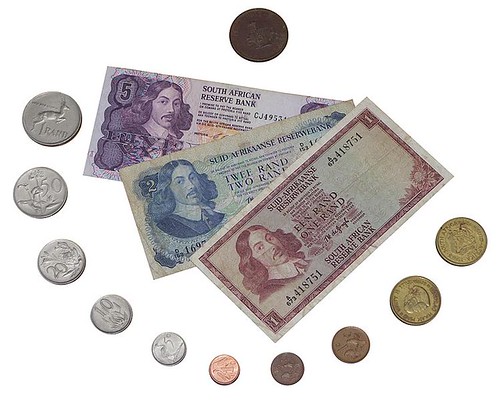
en.wikipedia.org/wiki/South_African_rand
